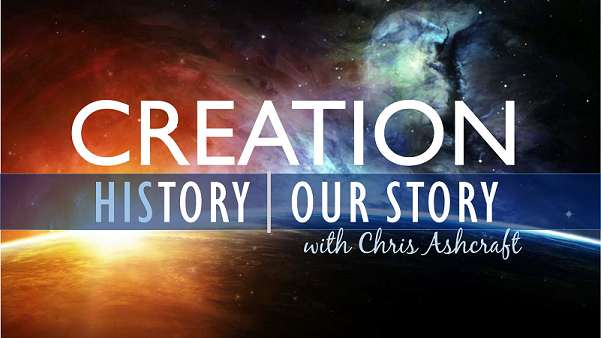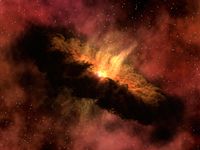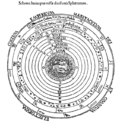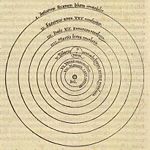Solar System: The Biblical View
| Student files |
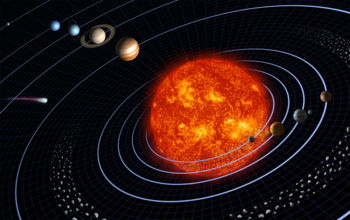 A solar
system is a group of heavenly bodies consisting of
a star and the planets and other objects orbiting around it. Our
system consists of the sun and
the planetary bodies orbiting it such as the eight (formerly nine) planets,
three dwarf
planets, about 160 known planetary satellites (moons),
and countless asteroids.
The solar system also consists of many various icy bodies, and vast
amounts of nebula, gas and dust known as the interplanetary medium.[1]
A solar
system is a group of heavenly bodies consisting of
a star and the planets and other objects orbiting around it. Our
system consists of the sun and
the planetary bodies orbiting it such as the eight (formerly nine) planets,
three dwarf
planets, about 160 known planetary satellites (moons),
and countless asteroids.
The solar system also consists of many various icy bodies, and vast
amounts of nebula, gas and dust known as the interplanetary medium.[1]
Besides the sun, Earth, and Earth's moon, many objects in our solar system are visible to the unaided eye. These objects include the planets Mercury, Venus, Mars, Jupiter, and Saturn; the brightest asteroids; and occasional comets and meteors. Many more objects in the solar system can be seen with telescopes.[2]
Characteristics
Sun
- Main Article: Sun
The sun is the largest and most important object in our solar system. It is the closest star to Earth and thus the most prominent star in our galaxy. From the sun's center to its surface, it is about 109 times the radius of Earth. Some of the streams of gas rising from the solar surface are larger than Earth. It accounts for more than 99 percent of the total solar system material,[3] about 99.8 percent of the solar system's mass (quantity of matter). Its chemical composition consists of 73.46% of Hydrogen and 24.85% of Helium.[4] The sun provides most of the heat, light, and other energy that makes life possible.
The sun's outer layers are hot and stormy. The hot gases and electrically charged particles in those layers continually stream into space and often burst out in solar eruptions. This flow of gases and particles forms the solar wind, which bathes everything in the solar system.[2]
Planets
- Main Article: Planet
The word planet comes from the Greek word πλανήτης (planetes) which is derived from the word πλάνης (planes) meaning "wanderer."[5]
Terrestrial Planets
The inner four planets consist chiefly of iron and rock, Mercury, Venus,
Earth and Mars.
They are called the terrestrial
planets because they have solid rocky surfaces, and
are somewhat similar in size and composition to the Earth.[2]
Gas Giants
Beyond the orbit of Mars lie Jupiter, Saturn, Uranus and Neptune,
the gas
giants of our solar system. The four outer planets
are giant worlds with thick, gaseous outer layers. Almost all their
mass consists of hydrogen and helium, giving them compositions more
like that of the sun than that of Earth. Beneath their outer layers,
the giant planets have no solid surfaces. The pressure of their
thick atmospheres turns their insides liquid, though they may have
rocky cores.[2]
Dwarf Planets
The furthest and smallest once considered planet Pluto is
solid as ice when compared to the terrestrial
planets.[6] On
August 24, 2006, the International Astronomical Union (IAU) formally
downgraded Pluto from
an official planet of
our solar system to a mere dwarf
planet. This occurred following the discovery of Eris,
a scatter-disk object heavier even than Pluto but which, like Pluto,
had not cleared its neighborhood of debris. There are now eight
official planets of our solar system according to the IAU.[7] The
dwarf planet class includes Eris, Pluto, and the former asteroid Ceres,
which is at least large enough to collapse under its own weight into
a spheroid.
Moons
- Main Article: Moon
A moon is a natural satellite that orbits a planet or dwarf planet. The body known as The Moon is the particular object in orbit around the Earth, but nearly 200 other moons are known to exist in our solar system, in orbit around six of the eight planets and two of the dwarf planets (Pluto and Eris). For example, Jupiter has more than sixty satellites, including its four largest, the Galilean moons. The Earth's moon is the brightest object in the night sky, reflecting the light from the sun. The moon is the only astronomical body other than Earth ever visited by human beings.
Origin
Evolution
- Main Article: Nebula theory
Cosmologists who hold to a naturalistic origin of our solar system believes that it formed from a giant, rotating cloud of gas and dust known as the solar nebula. According to this theory, the solar nebula began to collapse because of its own gravity. Some astronomers speculate that a nearby supernova (exploding star) triggered the collapse. As the nebula contracted, it spun faster and flattened into a disk.
The nebular theory indicates that particles within the flattened disk then collided and stuck together to form asteroid-sized objects called planetesimals. Some of these planetesimals combined to become the nine large planets. Other planetesimals formed moons, asteroids, and comets. The planets and asteroids all revolve around the sun in the same direction, and in more or less the same plane, because they originally formed from this flattened disk.
Most of the material in the solar nebula, however, was pulled toward the center and formed the sun. According to the theory, the pressure at the center became great enough to trigger the nuclear reactions that power the sun. Eventually, solar eruptions occurred, producing a solar wind. In the inner solar system, the wind was so powerful that it swept away most of the lighter elements -- hydrogen and helium. In the outer regions of the solar system, however, the solar wind was much weaker. As a result, much more hydrogen and helium remained on the outer planets. This process explains why the inner planets are small, rocky worlds and the outer planets, except for Pluto, are giant balls composed almost entirely of hydrogen and helium.[2]
Creation
- Main Article: Young solar system evidence
According to Genesis the solar system and laws to govern it were created during the 4th day of creation along with other celestial bodies.
14 And God said, "Let there be lights in the expanse of the sky to separate the day from the night, and let them serve as signs to mark seasons and days and years, 15 and let them be lights in the expanse of the sky to give light on the earth." And it was so. 16 God made two great lights—the greater light to govern the day and the lesser light to govern the night. He also made the stars. 17 God set them in the expanse of the sky to give light on the earth, 18 to govern the day and the night, and to separate light from darkness. And God saw that it was good. 19 And there was evening, and there was morning—the fourth day. Genesis 1:14-19 (NIV)
On the first day of the creation week God said, "Let there be light." On the fourth day He said, "Let there be lights." Culminations of mass came together on the fourth day at God's command to form the "two great lights"—the sun and the moon. These were to be signs to mark seasons, days and years. The fact that there were seasons in this early period of the universe means the earth must have had an inclination at its axis from the beginning--another problem for uniformitarian theories.
God then arranged other suns (the stars) in massive numbers throughout the universe. He even gave names to the stars and constellations (Job 38:31-33 ; Isaiah 40:26 ).
History
Geocentric Model
- Main Article: Geocentricity
Geocentrism is the belief that the Earth is located at the center of the universe. Biblical creationists generally view the creation of the cosmos as an Earth-centered event, and the space beyond our world created simply to "declare the glory of God" (Psalm 19:1 ). Therefore, it is largely assumed the Earth is at the relative center of the cosmos.[Reference needed]
While very few creationist hold to a strict geocentric view, galactocentricity has received acceptance by many. Evidence, such as quantized redshift, has been offered as strong support that the Milky Way exists at the center of the universe.
Heliocentric Model
- Main Article: Heliocentricity
Heliocentricity is a reference system where the sun is at the center. Our planetary system is heliocentric wherein the eight known planets are orbiting the sun, and is therefore known as a "solar system".
Early astronomers such as Nicolas Copernicus, Galileo Galilei, and Johannes Kepler helped revolutionize the previously held view of geocentrism, which was supported by Ptolemaic cosmology, and placed the Earth at the center. The Copernican theory proposed that the sun was the center of the universe and the planets rotated around the sun each year. He also asserted that Earth had motion around its center, and a simple explanation for the retrograde motions of the planets.
Other Solar Systems
Several other stars have disk-shaped clouds around them that seem to be solar systems in formation. In 1983, an infrared telescope in space photographed such a disk around Vega, the brightest star in the constellation Lyra. This discovery represented the first direct evidence of such material around any star except the sun. In 1984, astronomers photographed a similar disk around Beta Pictoris, a star in the southern constellation Pictor.
Since the 1990's, astronomers have discovered many planets orbiting distant stars, though the planets cannot be seen directly. By studying the masses and orbits of these planets, astronomers hope to learn more about solar systems in general. For example, our own solar system contains four small, rocky planets near the sun—Mercury, Venus, Earth, and Mars—and four giant, gaseous planets farther out—Jupiter, Saturn, Uranus, and Neptune. Astronomers were surprised to find that other stars have giant, gaseous planets in close orbits. For example, a planet nearly the size of Jupiter orbits the star 51 Pegasi closer than Mercury orbits our own Sun.
By the early 2000's, astronomers had discovered that more than 50 stars like our sun have planets orbiting them. In almost all cases, they found only one planet per star. All the planets found are probably gaseous with no solid surface.[2]
News
- Mystery of extrasolar planets' eccentric orbits - evidence suggests that, as far as planetary systems go, our solar system might be special indeed. April 19, 2005
- Maybe evolution didn't tune our universe after all New Scientist January 6, 2007
Solar system
References
-
↑ Arnett,
Bill. "An
Overview of the Solar System." The
Nine8 Planets, August 25, 2005. Accessed March 10, 2008. - ↑ 2.0 2.1 2.2 2.3 2.4 2.5 Worldbook at NASA: Solar System by the U.S. National Aeronautic and Space Administration
- ↑ DeYoung, Donald B (2010). Astronomy and the Bible: Questions and Answers. Winona Lake, IN: BMH Books. p. 29. ISBN 978-0-88469-267-6.
- ↑ Moore, Patrick; Hunt, Gary (1983). Atlas of the Solar System. Chicago: Rand McNally & Company. p. 19. ISBN 0-528-81122-3.
- ↑ "Entry for 'planet'," Wiktionary, January 9, 2008. Accessed January 14, 2008.
- ↑ "Our Solar System." NASA. Accessed March 10, 2008.
- ↑ "The Final IAU Resolution on the definition of "planet" ready for voting." International Astronomical Union, August 24, 2006. Accessed March 10, 2008.
- ↑ God and Cosmos by John Byl. p17-18
The Solar System: Wonderfully Designed for
Us
| Student files | Teacher files |
